Stimulant Drugs: Evaluating Effects on Academic Performance and Health
VerifiedAdded on 2020/04/01
|12
|2760
|500
Report
AI Summary
This report examines the use of stimulant drugs to enhance academic performance, focusing on a case study of a university student and analyzing two research articles. The report delves into the authors' expertise, affiliations, and potential conflicts of interest. It explores the research questions, aims, hypotheses, and justifications for the studies, including the methodology used, participants involved, and findings. The report also considers the barriers to applying evidence in practice and aligns the research studies with the PICO elements, providing a comprehensive overview of the topic and its implications for student health and academic outcomes. The report highlights the potential negative impacts of long-term stimulant use, the importance of understanding the risks, and the need for further research and support for students.
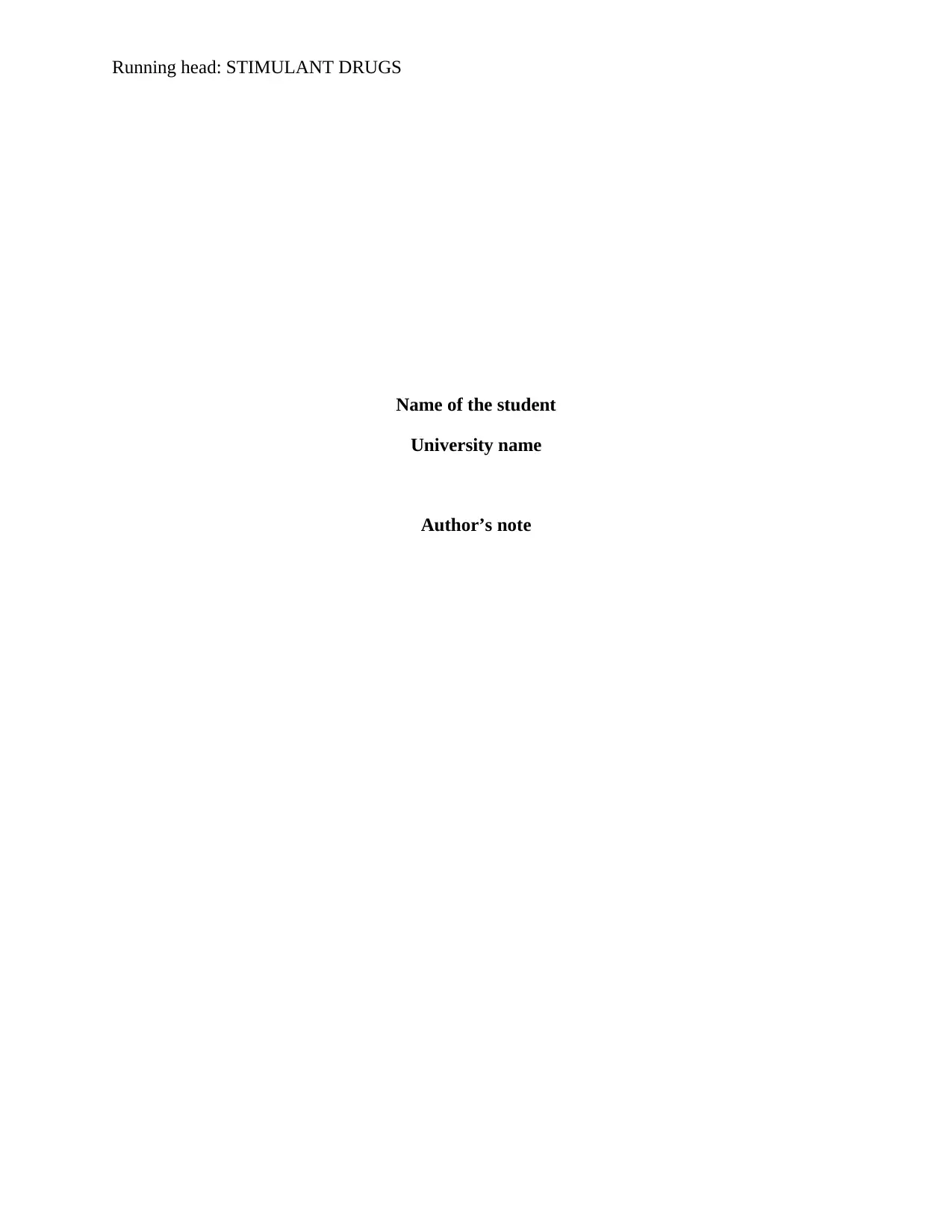
Running head: STIMULANT DRUGS
Name of the student
University name
Author’s note
Name of the student
University name
Author’s note
Paraphrase This Document
Need a fresh take? Get an instant paraphrase of this document with our AI Paraphraser
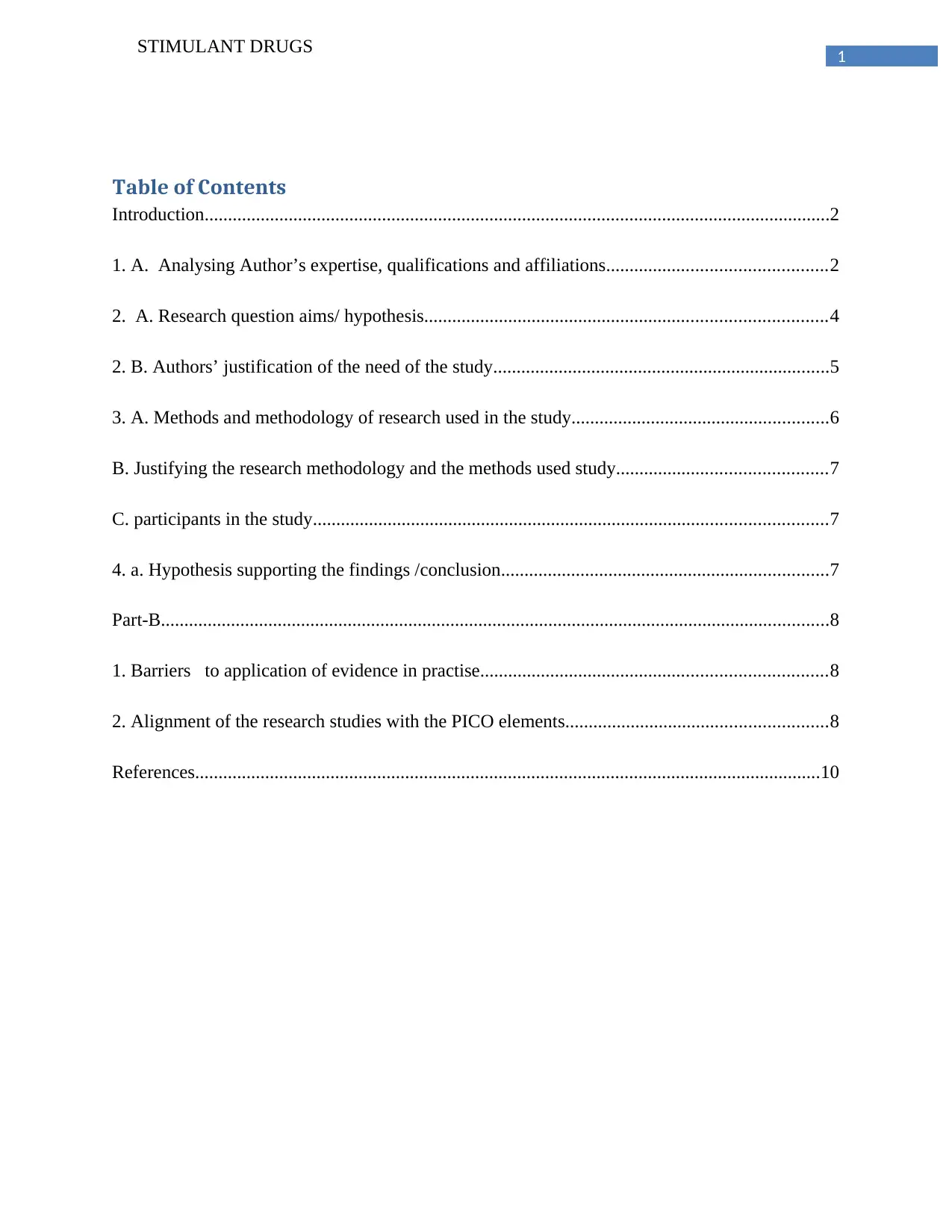
1
STIMULANT DRUGS
Table of Contents
Introduction......................................................................................................................................2
1. A. Analysing Author’s expertise, qualifications and affiliations...............................................2
2. A. Research question aims/ hypothesis......................................................................................4
2. B. Authors’ justification of the need of the study........................................................................5
3. A. Methods and methodology of research used in the study.......................................................6
B. Justifying the research methodology and the methods used study.............................................7
C. participants in the study..............................................................................................................7
4. a. Hypothesis supporting the findings /conclusion......................................................................7
Part-B...............................................................................................................................................8
1. Barriers to application of evidence in practise..........................................................................8
2. Alignment of the research studies with the PICO elements........................................................8
References......................................................................................................................................10
STIMULANT DRUGS
Table of Contents
Introduction......................................................................................................................................2
1. A. Analysing Author’s expertise, qualifications and affiliations...............................................2
2. A. Research question aims/ hypothesis......................................................................................4
2. B. Authors’ justification of the need of the study........................................................................5
3. A. Methods and methodology of research used in the study.......................................................6
B. Justifying the research methodology and the methods used study.............................................7
C. participants in the study..............................................................................................................7
4. a. Hypothesis supporting the findings /conclusion......................................................................7
Part-B...............................................................................................................................................8
1. Barriers to application of evidence in practise..........................................................................8
2. Alignment of the research studies with the PICO elements........................................................8
References......................................................................................................................................10
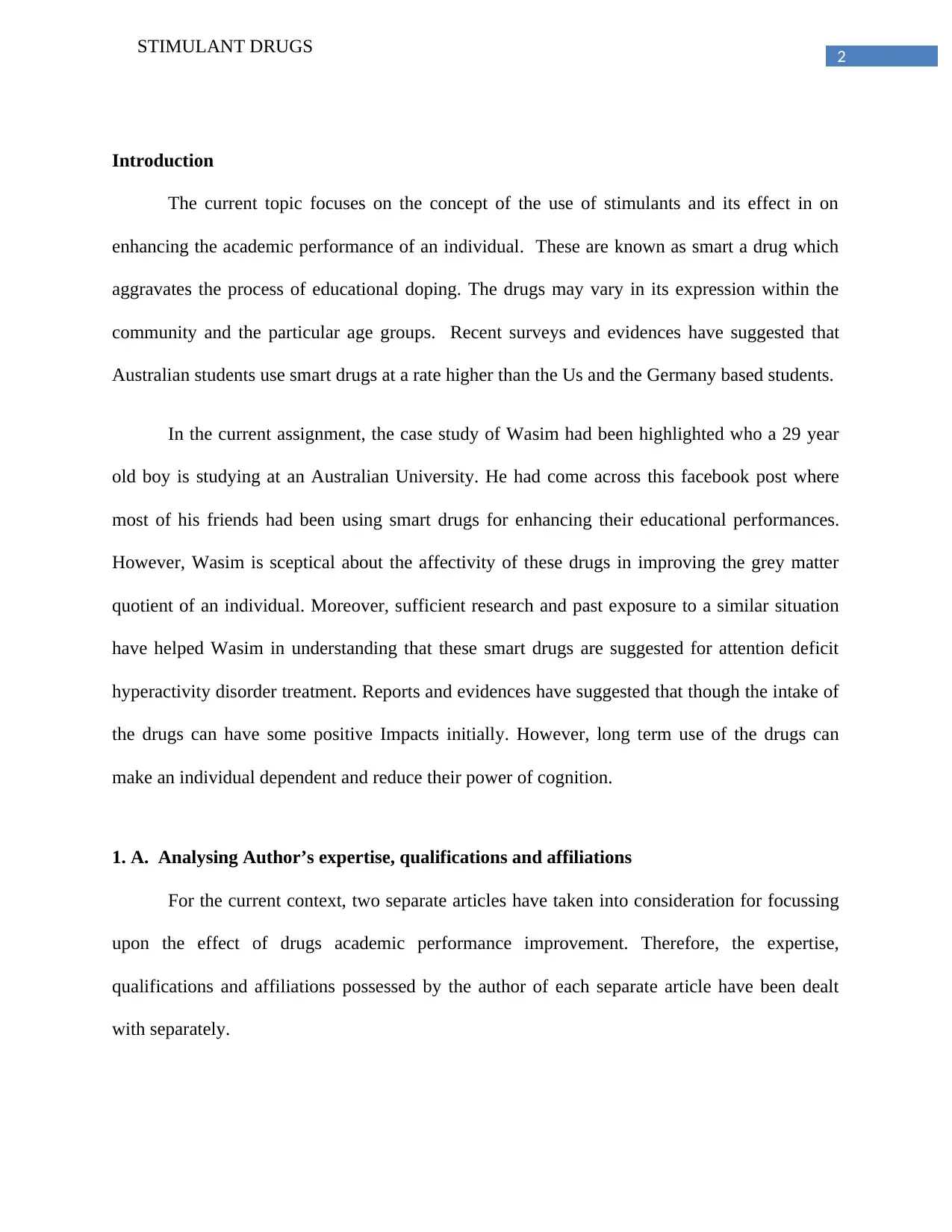
2
STIMULANT DRUGS
Introduction
The current topic focuses on the concept of the use of stimulants and its effect in on
enhancing the academic performance of an individual. These are known as smart a drug which
aggravates the process of educational doping. The drugs may vary in its expression within the
community and the particular age groups. Recent surveys and evidences have suggested that
Australian students use smart drugs at a rate higher than the Us and the Germany based students.
In the current assignment, the case study of Wasim had been highlighted who a 29 year
old boy is studying at an Australian University. He had come across this facebook post where
most of his friends had been using smart drugs for enhancing their educational performances.
However, Wasim is sceptical about the affectivity of these drugs in improving the grey matter
quotient of an individual. Moreover, sufficient research and past exposure to a similar situation
have helped Wasim in understanding that these smart drugs are suggested for attention deficit
hyperactivity disorder treatment. Reports and evidences have suggested that though the intake of
the drugs can have some positive Impacts initially. However, long term use of the drugs can
make an individual dependent and reduce their power of cognition.
1. A. Analysing Author’s expertise, qualifications and affiliations
For the current context, two separate articles have taken into consideration for focussing
upon the effect of drugs academic performance improvement. Therefore, the expertise,
qualifications and affiliations possessed by the author of each separate article have been dealt
with separately.
STIMULANT DRUGS
Introduction
The current topic focuses on the concept of the use of stimulants and its effect in on
enhancing the academic performance of an individual. These are known as smart a drug which
aggravates the process of educational doping. The drugs may vary in its expression within the
community and the particular age groups. Recent surveys and evidences have suggested that
Australian students use smart drugs at a rate higher than the Us and the Germany based students.
In the current assignment, the case study of Wasim had been highlighted who a 29 year
old boy is studying at an Australian University. He had come across this facebook post where
most of his friends had been using smart drugs for enhancing their educational performances.
However, Wasim is sceptical about the affectivity of these drugs in improving the grey matter
quotient of an individual. Moreover, sufficient research and past exposure to a similar situation
have helped Wasim in understanding that these smart drugs are suggested for attention deficit
hyperactivity disorder treatment. Reports and evidences have suggested that though the intake of
the drugs can have some positive Impacts initially. However, long term use of the drugs can
make an individual dependent and reduce their power of cognition.
1. A. Analysing Author’s expertise, qualifications and affiliations
For the current context, two separate articles have taken into consideration for focussing
upon the effect of drugs academic performance improvement. Therefore, the expertise,
qualifications and affiliations possessed by the author of each separate article have been dealt
with separately.
⊘ This is a preview!⊘
Do you want full access?
Subscribe today to unlock all pages.

Trusted by 1+ million students worldwide
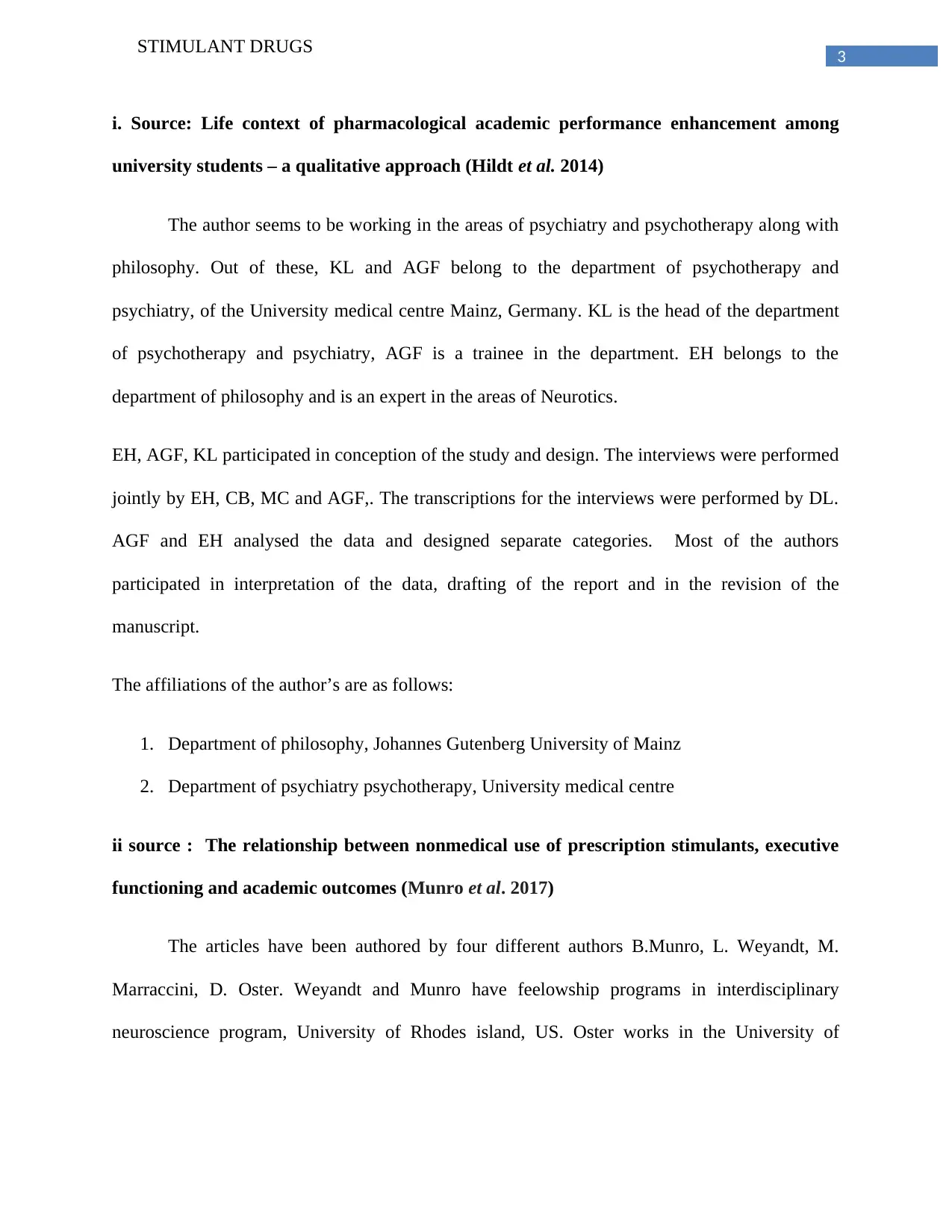
3
STIMULANT DRUGS
i. Source: Life context of pharmacological academic performance enhancement among
university students – a qualitative approach (Hildt et al. 2014)
The author seems to be working in the areas of psychiatry and psychotherapy along with
philosophy. Out of these, KL and AGF belong to the department of psychotherapy and
psychiatry, of the University medical centre Mainz, Germany. KL is the head of the department
of psychotherapy and psychiatry, AGF is a trainee in the department. EH belongs to the
department of philosophy and is an expert in the areas of Neurotics.
EH, AGF, KL participated in conception of the study and design. The interviews were performed
jointly by EH, CB, MC and AGF,. The transcriptions for the interviews were performed by DL.
AGF and EH analysed the data and designed separate categories. Most of the authors
participated in interpretation of the data, drafting of the report and in the revision of the
manuscript.
The affiliations of the author’s are as follows:
1. Department of philosophy, Johannes Gutenberg University of Mainz
2. Department of psychiatry psychotherapy, University medical centre
ii source : The relationship between nonmedical use of prescription stimulants, executive
functioning and academic outcomes (Munro et al. 2017)
The articles have been authored by four different authors B.Munro, L. Weyandt, M.
Marraccini, D. Oster. Weyandt and Munro have feelowship programs in interdisciplinary
neuroscience program, University of Rhodes island, US. Oster works in the University of
STIMULANT DRUGS
i. Source: Life context of pharmacological academic performance enhancement among
university students – a qualitative approach (Hildt et al. 2014)
The author seems to be working in the areas of psychiatry and psychotherapy along with
philosophy. Out of these, KL and AGF belong to the department of psychotherapy and
psychiatry, of the University medical centre Mainz, Germany. KL is the head of the department
of psychotherapy and psychiatry, AGF is a trainee in the department. EH belongs to the
department of philosophy and is an expert in the areas of Neurotics.
EH, AGF, KL participated in conception of the study and design. The interviews were performed
jointly by EH, CB, MC and AGF,. The transcriptions for the interviews were performed by DL.
AGF and EH analysed the data and designed separate categories. Most of the authors
participated in interpretation of the data, drafting of the report and in the revision of the
manuscript.
The affiliations of the author’s are as follows:
1. Department of philosophy, Johannes Gutenberg University of Mainz
2. Department of psychiatry psychotherapy, University medical centre
ii source : The relationship between nonmedical use of prescription stimulants, executive
functioning and academic outcomes (Munro et al. 2017)
The articles have been authored by four different authors B.Munro, L. Weyandt, M.
Marraccini, D. Oster. Weyandt and Munro have feelowship programs in interdisciplinary
neuroscience program, University of Rhodes island, US. Oster works in the University of
Paraphrase This Document
Need a fresh take? Get an instant paraphrase of this document with our AI Paraphraser
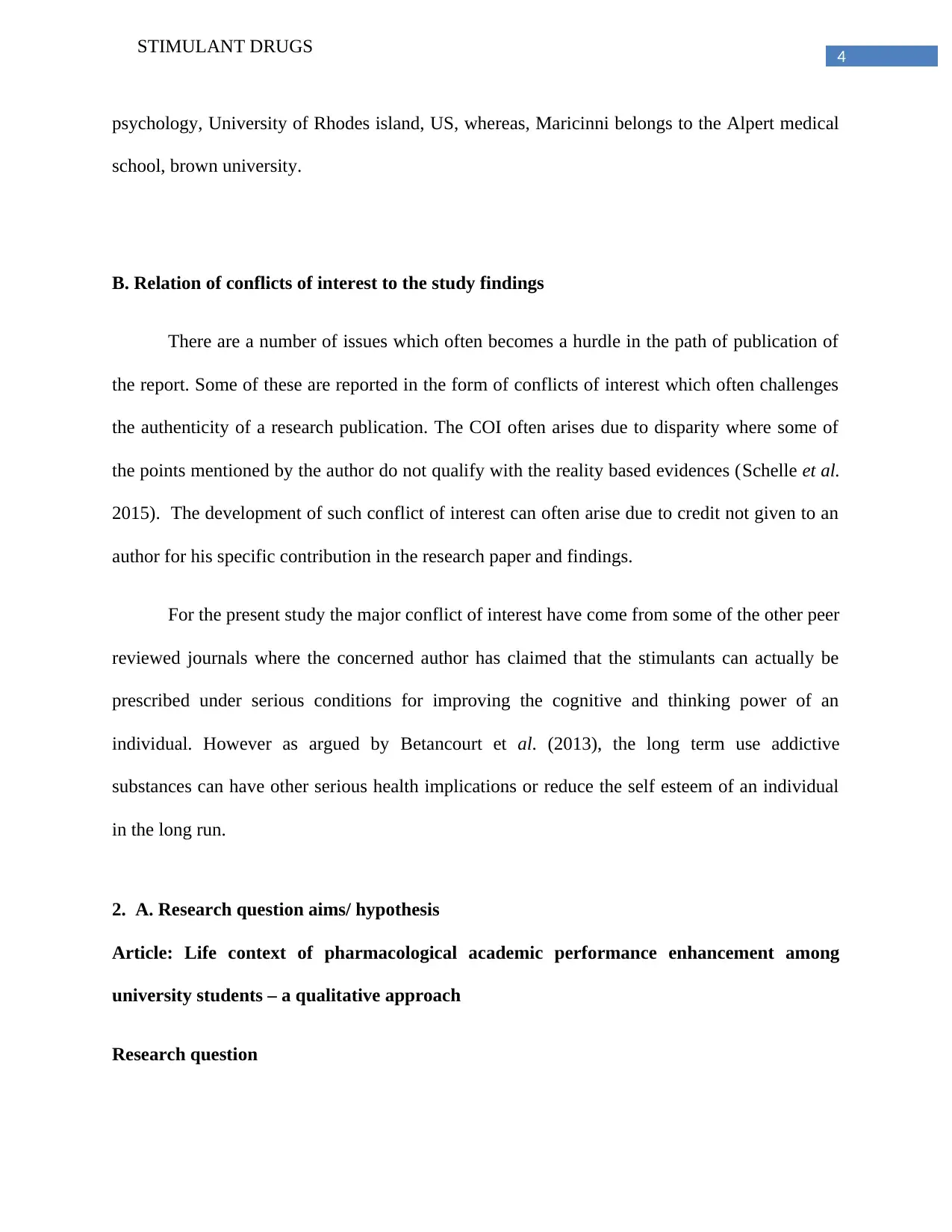
4
STIMULANT DRUGS
psychology, University of Rhodes island, US, whereas, Maricinni belongs to the Alpert medical
school, brown university.
B. Relation of conflicts of interest to the study findings
There are a number of issues which often becomes a hurdle in the path of publication of
the report. Some of these are reported in the form of conflicts of interest which often challenges
the authenticity of a research publication. The COI often arises due to disparity where some of
the points mentioned by the author do not qualify with the reality based evidences (Schelle et al.
2015). The development of such conflict of interest can often arise due to credit not given to an
author for his specific contribution in the research paper and findings.
For the present study the major conflict of interest have come from some of the other peer
reviewed journals where the concerned author has claimed that the stimulants can actually be
prescribed under serious conditions for improving the cognitive and thinking power of an
individual. However as argued by Betancourt et al. (2013), the long term use addictive
substances can have other serious health implications or reduce the self esteem of an individual
in the long run.
2. A. Research question aims/ hypothesis
Article: Life context of pharmacological academic performance enhancement among
university students – a qualitative approach
Research question
STIMULANT DRUGS
psychology, University of Rhodes island, US, whereas, Maricinni belongs to the Alpert medical
school, brown university.
B. Relation of conflicts of interest to the study findings
There are a number of issues which often becomes a hurdle in the path of publication of
the report. Some of these are reported in the form of conflicts of interest which often challenges
the authenticity of a research publication. The COI often arises due to disparity where some of
the points mentioned by the author do not qualify with the reality based evidences (Schelle et al.
2015). The development of such conflict of interest can often arise due to credit not given to an
author for his specific contribution in the research paper and findings.
For the present study the major conflict of interest have come from some of the other peer
reviewed journals where the concerned author has claimed that the stimulants can actually be
prescribed under serious conditions for improving the cognitive and thinking power of an
individual. However as argued by Betancourt et al. (2013), the long term use addictive
substances can have other serious health implications or reduce the self esteem of an individual
in the long run.
2. A. Research question aims/ hypothesis
Article: Life context of pharmacological academic performance enhancement among
university students – a qualitative approach
Research question
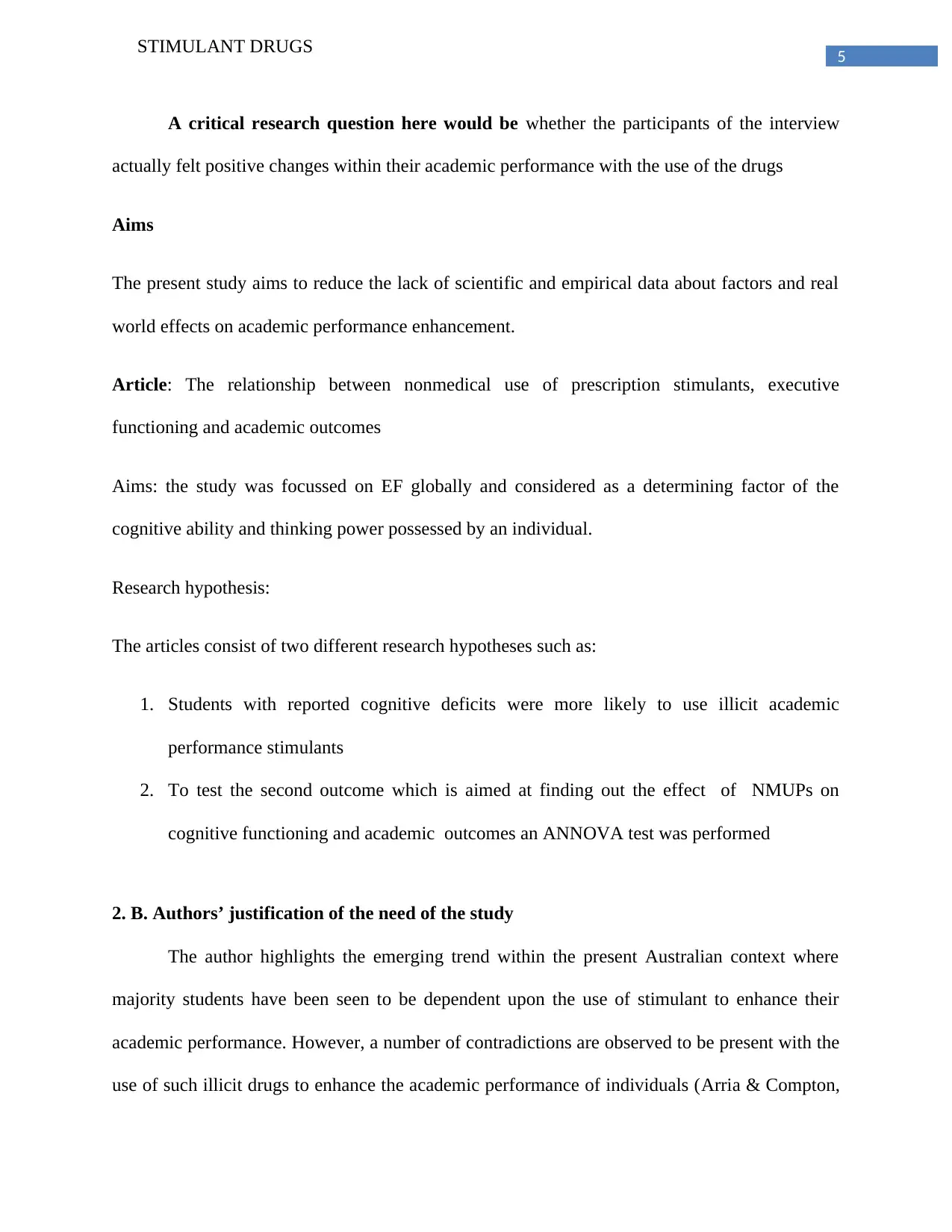
5
STIMULANT DRUGS
A critical research question here would be whether the participants of the interview
actually felt positive changes within their academic performance with the use of the drugs
Aims
The present study aims to reduce the lack of scientific and empirical data about factors and real
world effects on academic performance enhancement.
Article: The relationship between nonmedical use of prescription stimulants, executive
functioning and academic outcomes
Aims: the study was focussed on EF globally and considered as a determining factor of the
cognitive ability and thinking power possessed by an individual.
Research hypothesis:
The articles consist of two different research hypotheses such as:
1. Students with reported cognitive deficits were more likely to use illicit academic
performance stimulants
2. To test the second outcome which is aimed at finding out the effect of NMUPs on
cognitive functioning and academic outcomes an ANNOVA test was performed
2. B. Authors’ justification of the need of the study
The author highlights the emerging trend within the present Australian context where
majority students have been seen to be dependent upon the use of stimulant to enhance their
academic performance. However, a number of contradictions are observed to be present with the
use of such illicit drugs to enhance the academic performance of individuals (Arria & Compton,
STIMULANT DRUGS
A critical research question here would be whether the participants of the interview
actually felt positive changes within their academic performance with the use of the drugs
Aims
The present study aims to reduce the lack of scientific and empirical data about factors and real
world effects on academic performance enhancement.
Article: The relationship between nonmedical use of prescription stimulants, executive
functioning and academic outcomes
Aims: the study was focussed on EF globally and considered as a determining factor of the
cognitive ability and thinking power possessed by an individual.
Research hypothesis:
The articles consist of two different research hypotheses such as:
1. Students with reported cognitive deficits were more likely to use illicit academic
performance stimulants
2. To test the second outcome which is aimed at finding out the effect of NMUPs on
cognitive functioning and academic outcomes an ANNOVA test was performed
2. B. Authors’ justification of the need of the study
The author highlights the emerging trend within the present Australian context where
majority students have been seen to be dependent upon the use of stimulant to enhance their
academic performance. However, a number of contradictions are observed to be present with the
use of such illicit drugs to enhance the academic performance of individuals (Arria & Compton,
⊘ This is a preview!⊘
Do you want full access?
Subscribe today to unlock all pages.

Trusted by 1+ million students worldwide
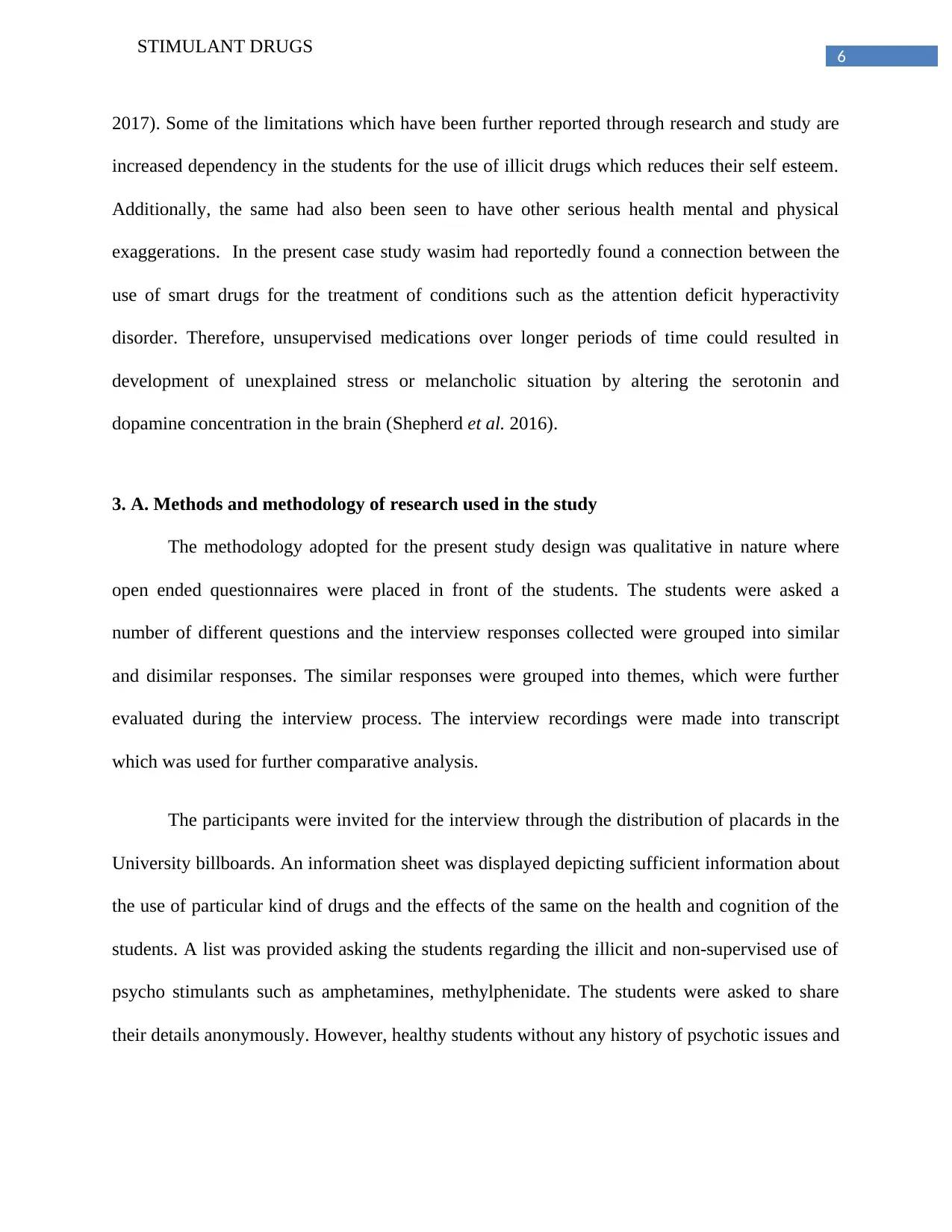
6
STIMULANT DRUGS
2017). Some of the limitations which have been further reported through research and study are
increased dependency in the students for the use of illicit drugs which reduces their self esteem.
Additionally, the same had also been seen to have other serious health mental and physical
exaggerations. In the present case study wasim had reportedly found a connection between the
use of smart drugs for the treatment of conditions such as the attention deficit hyperactivity
disorder. Therefore, unsupervised medications over longer periods of time could resulted in
development of unexplained stress or melancholic situation by altering the serotonin and
dopamine concentration in the brain (Shepherd et al. 2016).
3. A. Methods and methodology of research used in the study
The methodology adopted for the present study design was qualitative in nature where
open ended questionnaires were placed in front of the students. The students were asked a
number of different questions and the interview responses collected were grouped into similar
and disimilar responses. The similar responses were grouped into themes, which were further
evaluated during the interview process. The interview recordings were made into transcript
which was used for further comparative analysis.
The participants were invited for the interview through the distribution of placards in the
University billboards. An information sheet was displayed depicting sufficient information about
the use of particular kind of drugs and the effects of the same on the health and cognition of the
students. A list was provided asking the students regarding the illicit and non-supervised use of
psycho stimulants such as amphetamines, methylphenidate. The students were asked to share
their details anonymously. However, healthy students without any history of psychotic issues and
STIMULANT DRUGS
2017). Some of the limitations which have been further reported through research and study are
increased dependency in the students for the use of illicit drugs which reduces their self esteem.
Additionally, the same had also been seen to have other serious health mental and physical
exaggerations. In the present case study wasim had reportedly found a connection between the
use of smart drugs for the treatment of conditions such as the attention deficit hyperactivity
disorder. Therefore, unsupervised medications over longer periods of time could resulted in
development of unexplained stress or melancholic situation by altering the serotonin and
dopamine concentration in the brain (Shepherd et al. 2016).
3. A. Methods and methodology of research used in the study
The methodology adopted for the present study design was qualitative in nature where
open ended questionnaires were placed in front of the students. The students were asked a
number of different questions and the interview responses collected were grouped into similar
and disimilar responses. The similar responses were grouped into themes, which were further
evaluated during the interview process. The interview recordings were made into transcript
which was used for further comparative analysis.
The participants were invited for the interview through the distribution of placards in the
University billboards. An information sheet was displayed depicting sufficient information about
the use of particular kind of drugs and the effects of the same on the health and cognition of the
students. A list was provided asking the students regarding the illicit and non-supervised use of
psycho stimulants such as amphetamines, methylphenidate. The students were asked to share
their details anonymously. However, healthy students without any history of psychotic issues and
Paraphrase This Document
Need a fresh take? Get an instant paraphrase of this document with our AI Paraphraser
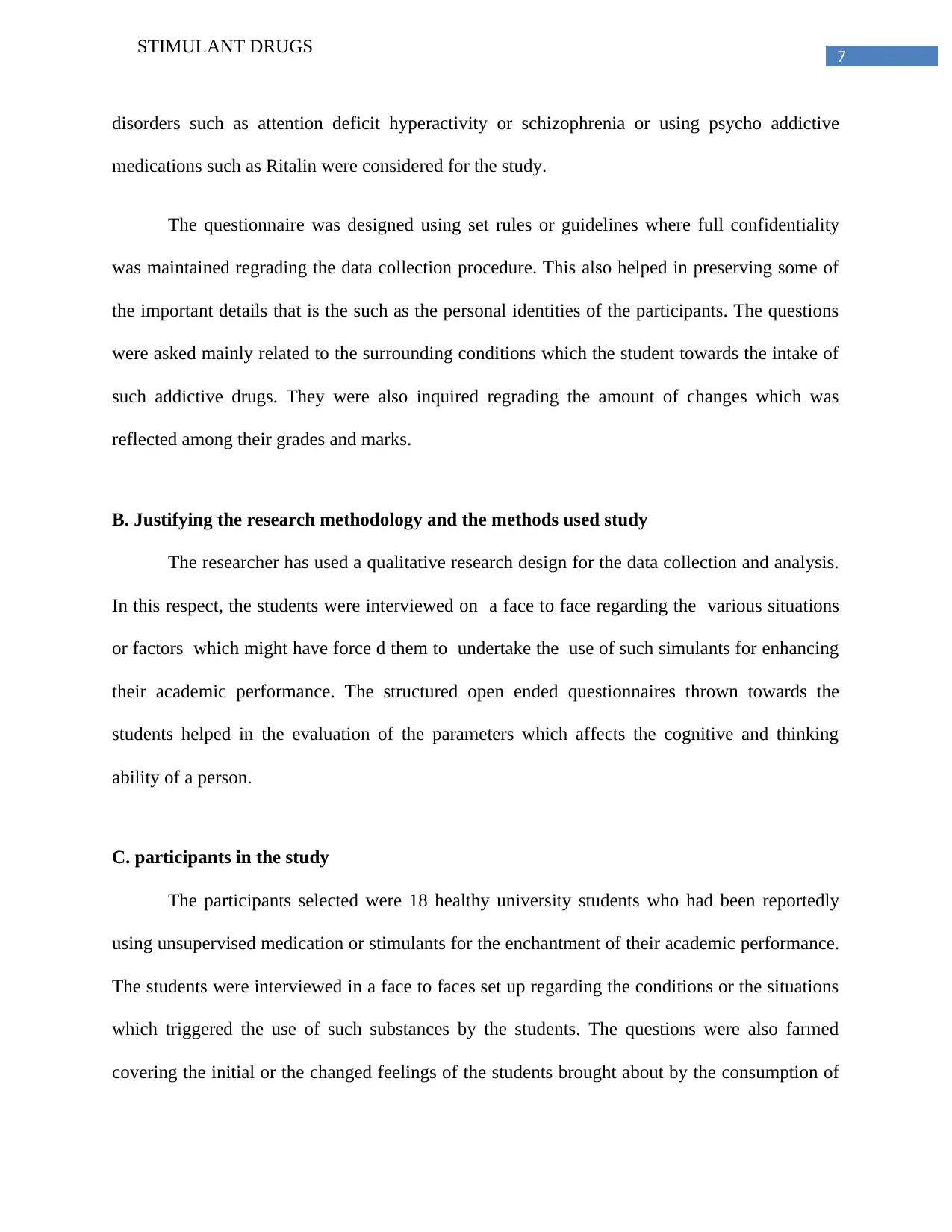
7
STIMULANT DRUGS
disorders such as attention deficit hyperactivity or schizophrenia or using psycho addictive
medications such as Ritalin were considered for the study.
The questionnaire was designed using set rules or guidelines where full confidentiality
was maintained regrading the data collection procedure. This also helped in preserving some of
the important details that is the such as the personal identities of the participants. The questions
were asked mainly related to the surrounding conditions which the student towards the intake of
such addictive drugs. They were also inquired regrading the amount of changes which was
reflected among their grades and marks.
B. Justifying the research methodology and the methods used study
The researcher has used a qualitative research design for the data collection and analysis.
In this respect, the students were interviewed on a face to face regarding the various situations
or factors which might have force d them to undertake the use of such simulants for enhancing
their academic performance. The structured open ended questionnaires thrown towards the
students helped in the evaluation of the parameters which affects the cognitive and thinking
ability of a person.
C. participants in the study
The participants selected were 18 healthy university students who had been reportedly
using unsupervised medication or stimulants for the enchantment of their academic performance.
The students were interviewed in a face to faces set up regarding the conditions or the situations
which triggered the use of such substances by the students. The questions were also farmed
covering the initial or the changed feelings of the students brought about by the consumption of
STIMULANT DRUGS
disorders such as attention deficit hyperactivity or schizophrenia or using psycho addictive
medications such as Ritalin were considered for the study.
The questionnaire was designed using set rules or guidelines where full confidentiality
was maintained regrading the data collection procedure. This also helped in preserving some of
the important details that is the such as the personal identities of the participants. The questions
were asked mainly related to the surrounding conditions which the student towards the intake of
such addictive drugs. They were also inquired regrading the amount of changes which was
reflected among their grades and marks.
B. Justifying the research methodology and the methods used study
The researcher has used a qualitative research design for the data collection and analysis.
In this respect, the students were interviewed on a face to face regarding the various situations
or factors which might have force d them to undertake the use of such simulants for enhancing
their academic performance. The structured open ended questionnaires thrown towards the
students helped in the evaluation of the parameters which affects the cognitive and thinking
ability of a person.
C. participants in the study
The participants selected were 18 healthy university students who had been reportedly
using unsupervised medication or stimulants for the enchantment of their academic performance.
The students were interviewed in a face to faces set up regarding the conditions or the situations
which triggered the use of such substances by the students. The questions were also farmed
covering the initial or the changed feelings of the students brought about by the consumption of
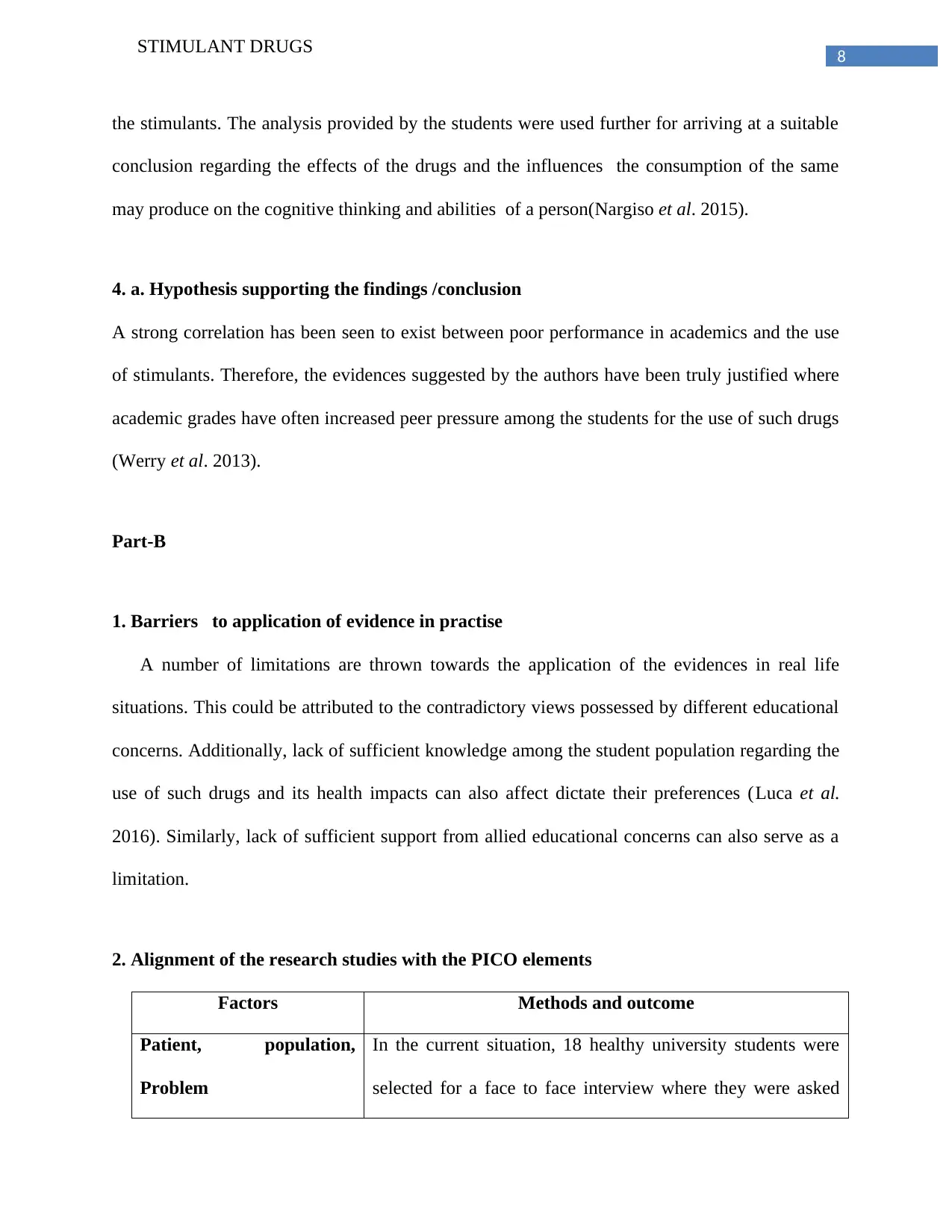
8
STIMULANT DRUGS
the stimulants. The analysis provided by the students were used further for arriving at a suitable
conclusion regarding the effects of the drugs and the influences the consumption of the same
may produce on the cognitive thinking and abilities of a person(Nargiso et al. 2015).
4. a. Hypothesis supporting the findings /conclusion
A strong correlation has been seen to exist between poor performance in academics and the use
of stimulants. Therefore, the evidences suggested by the authors have been truly justified where
academic grades have often increased peer pressure among the students for the use of such drugs
(Werry et al. 2013).
Part-B
1. Barriers to application of evidence in practise
A number of limitations are thrown towards the application of the evidences in real life
situations. This could be attributed to the contradictory views possessed by different educational
concerns. Additionally, lack of sufficient knowledge among the student population regarding the
use of such drugs and its health impacts can also affect dictate their preferences (Luca et al.
2016). Similarly, lack of sufficient support from allied educational concerns can also serve as a
limitation.
2. Alignment of the research studies with the PICO elements
Factors Methods and outcome
Patient, population,
Problem
In the current situation, 18 healthy university students were
selected for a face to face interview where they were asked
STIMULANT DRUGS
the stimulants. The analysis provided by the students were used further for arriving at a suitable
conclusion regarding the effects of the drugs and the influences the consumption of the same
may produce on the cognitive thinking and abilities of a person(Nargiso et al. 2015).
4. a. Hypothesis supporting the findings /conclusion
A strong correlation has been seen to exist between poor performance in academics and the use
of stimulants. Therefore, the evidences suggested by the authors have been truly justified where
academic grades have often increased peer pressure among the students for the use of such drugs
(Werry et al. 2013).
Part-B
1. Barriers to application of evidence in practise
A number of limitations are thrown towards the application of the evidences in real life
situations. This could be attributed to the contradictory views possessed by different educational
concerns. Additionally, lack of sufficient knowledge among the student population regarding the
use of such drugs and its health impacts can also affect dictate their preferences (Luca et al.
2016). Similarly, lack of sufficient support from allied educational concerns can also serve as a
limitation.
2. Alignment of the research studies with the PICO elements
Factors Methods and outcome
Patient, population,
Problem
In the current situation, 18 healthy university students were
selected for a face to face interview where they were asked
⊘ This is a preview!⊘
Do you want full access?
Subscribe today to unlock all pages.

Trusted by 1+ million students worldwide
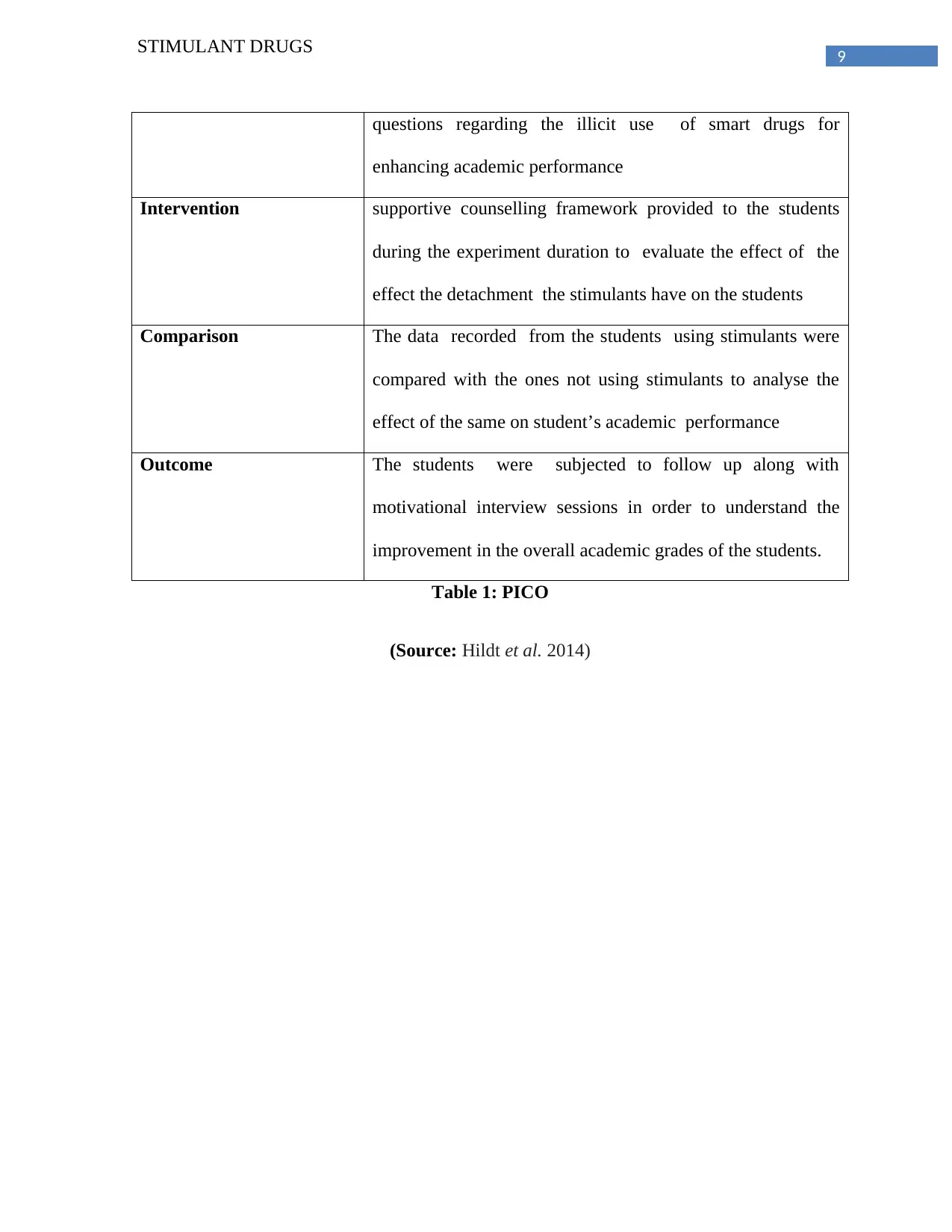
9
STIMULANT DRUGS
questions regarding the illicit use of smart drugs for
enhancing academic performance
Intervention supportive counselling framework provided to the students
during the experiment duration to evaluate the effect of the
effect the detachment the stimulants have on the students
Comparison The data recorded from the students using stimulants were
compared with the ones not using stimulants to analyse the
effect of the same on student’s academic performance
Outcome The students were subjected to follow up along with
motivational interview sessions in order to understand the
improvement in the overall academic grades of the students.
Table 1: PICO
(Source: Hildt et al. 2014)
STIMULANT DRUGS
questions regarding the illicit use of smart drugs for
enhancing academic performance
Intervention supportive counselling framework provided to the students
during the experiment duration to evaluate the effect of the
effect the detachment the stimulants have on the students
Comparison The data recorded from the students using stimulants were
compared with the ones not using stimulants to analyse the
effect of the same on student’s academic performance
Outcome The students were subjected to follow up along with
motivational interview sessions in order to understand the
improvement in the overall academic grades of the students.
Table 1: PICO
(Source: Hildt et al. 2014)
Paraphrase This Document
Need a fresh take? Get an instant paraphrase of this document with our AI Paraphraser
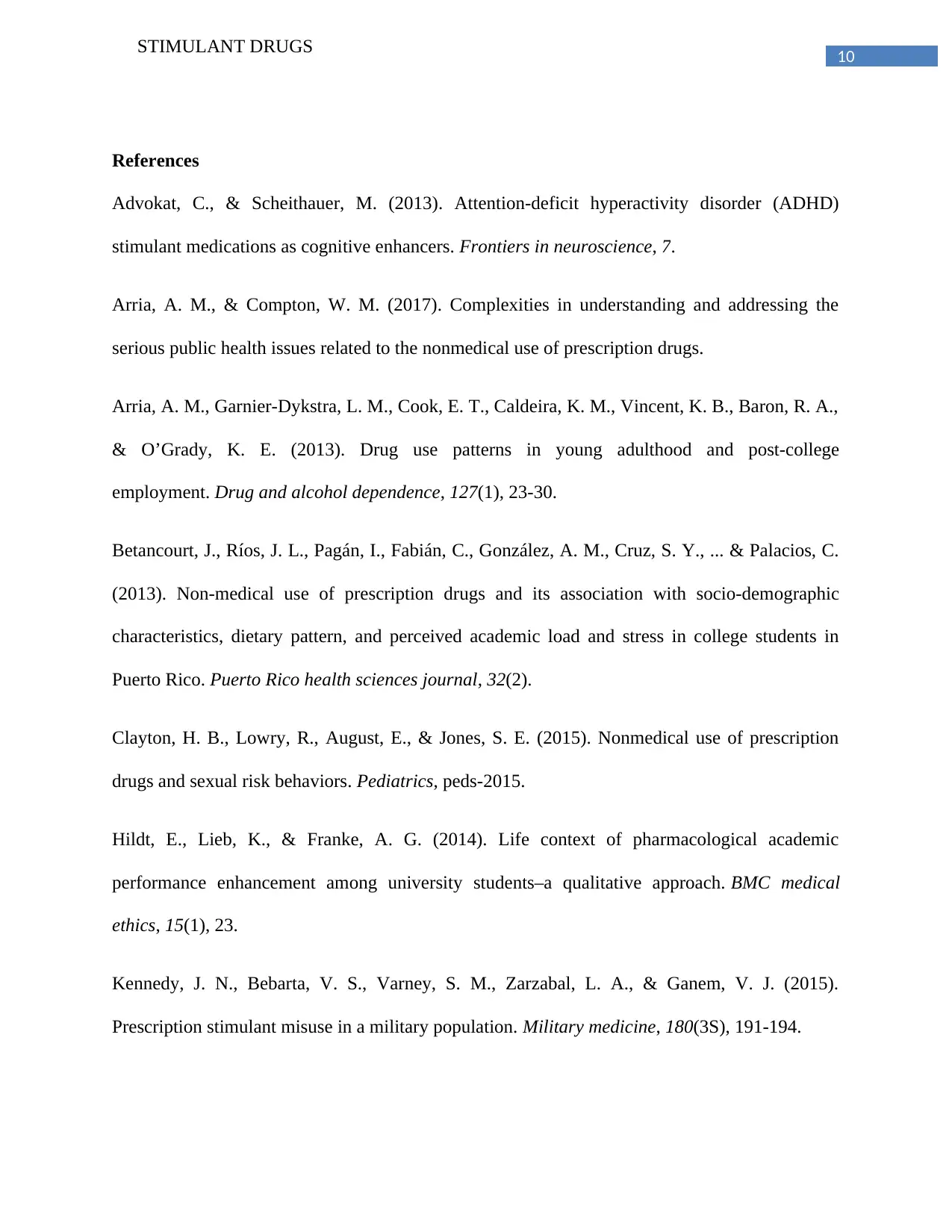
10
STIMULANT DRUGS
References
Advokat, C., & Scheithauer, M. (2013). Attention-deficit hyperactivity disorder (ADHD)
stimulant medications as cognitive enhancers. Frontiers in neuroscience, 7.
Arria, A. M., & Compton, W. M. (2017). Complexities in understanding and addressing the
serious public health issues related to the nonmedical use of prescription drugs.
Arria, A. M., Garnier-Dykstra, L. M., Cook, E. T., Caldeira, K. M., Vincent, K. B., Baron, R. A.,
& O’Grady, K. E. (2013). Drug use patterns in young adulthood and post-college
employment. Drug and alcohol dependence, 127(1), 23-30.
Betancourt, J., Ríos, J. L., Pagán, I., Fabián, C., González, A. M., Cruz, S. Y., ... & Palacios, C.
(2013). Non-medical use of prescription drugs and its association with socio-demographic
characteristics, dietary pattern, and perceived academic load and stress in college students in
Puerto Rico. Puerto Rico health sciences journal, 32(2).
Clayton, H. B., Lowry, R., August, E., & Jones, S. E. (2015). Nonmedical use of prescription
drugs and sexual risk behaviors. Pediatrics, peds-2015.
Hildt, E., Lieb, K., & Franke, A. G. (2014). Life context of pharmacological academic
performance enhancement among university students–a qualitative approach. BMC medical
ethics, 15(1), 23.
Kennedy, J. N., Bebarta, V. S., Varney, S. M., Zarzabal, L. A., & Ganem, V. J. (2015).
Prescription stimulant misuse in a military population. Military medicine, 180(3S), 191-194.
STIMULANT DRUGS
References
Advokat, C., & Scheithauer, M. (2013). Attention-deficit hyperactivity disorder (ADHD)
stimulant medications as cognitive enhancers. Frontiers in neuroscience, 7.
Arria, A. M., & Compton, W. M. (2017). Complexities in understanding and addressing the
serious public health issues related to the nonmedical use of prescription drugs.
Arria, A. M., Garnier-Dykstra, L. M., Cook, E. T., Caldeira, K. M., Vincent, K. B., Baron, R. A.,
& O’Grady, K. E. (2013). Drug use patterns in young adulthood and post-college
employment. Drug and alcohol dependence, 127(1), 23-30.
Betancourt, J., Ríos, J. L., Pagán, I., Fabián, C., González, A. M., Cruz, S. Y., ... & Palacios, C.
(2013). Non-medical use of prescription drugs and its association with socio-demographic
characteristics, dietary pattern, and perceived academic load and stress in college students in
Puerto Rico. Puerto Rico health sciences journal, 32(2).
Clayton, H. B., Lowry, R., August, E., & Jones, S. E. (2015). Nonmedical use of prescription
drugs and sexual risk behaviors. Pediatrics, peds-2015.
Hildt, E., Lieb, K., & Franke, A. G. (2014). Life context of pharmacological academic
performance enhancement among university students–a qualitative approach. BMC medical
ethics, 15(1), 23.
Kennedy, J. N., Bebarta, V. S., Varney, S. M., Zarzabal, L. A., & Ganem, V. J. (2015).
Prescription stimulant misuse in a military population. Military medicine, 180(3S), 191-194.
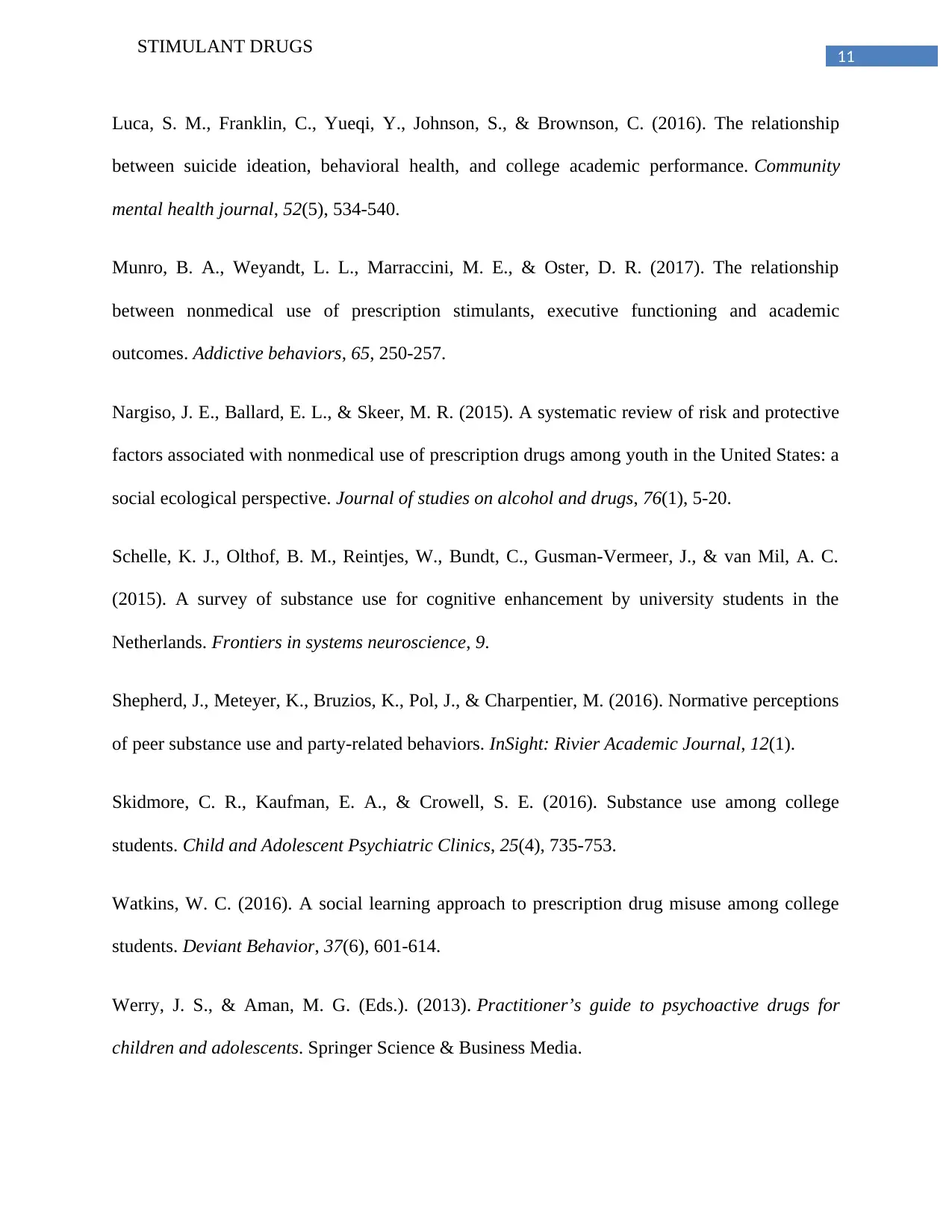
11
STIMULANT DRUGS
Luca, S. M., Franklin, C., Yueqi, Y., Johnson, S., & Brownson, C. (2016). The relationship
between suicide ideation, behavioral health, and college academic performance. Community
mental health journal, 52(5), 534-540.
Munro, B. A., Weyandt, L. L., Marraccini, M. E., & Oster, D. R. (2017). The relationship
between nonmedical use of prescription stimulants, executive functioning and academic
outcomes. Addictive behaviors, 65, 250-257.
Nargiso, J. E., Ballard, E. L., & Skeer, M. R. (2015). A systematic review of risk and protective
factors associated with nonmedical use of prescription drugs among youth in the United States: a
social ecological perspective. Journal of studies on alcohol and drugs, 76(1), 5-20.
Schelle, K. J., Olthof, B. M., Reintjes, W., Bundt, C., Gusman-Vermeer, J., & van Mil, A. C.
(2015). A survey of substance use for cognitive enhancement by university students in the
Netherlands. Frontiers in systems neuroscience, 9.
Shepherd, J., Meteyer, K., Bruzios, K., Pol, J., & Charpentier, M. (2016). Normative perceptions
of peer substance use and party-related behaviors. InSight: Rivier Academic Journal, 12(1).
Skidmore, C. R., Kaufman, E. A., & Crowell, S. E. (2016). Substance use among college
students. Child and Adolescent Psychiatric Clinics, 25(4), 735-753.
Watkins, W. C. (2016). A social learning approach to prescription drug misuse among college
students. Deviant Behavior, 37(6), 601-614.
Werry, J. S., & Aman, M. G. (Eds.). (2013). Practitioner’s guide to psychoactive drugs for
children and adolescents. Springer Science & Business Media.
STIMULANT DRUGS
Luca, S. M., Franklin, C., Yueqi, Y., Johnson, S., & Brownson, C. (2016). The relationship
between suicide ideation, behavioral health, and college academic performance. Community
mental health journal, 52(5), 534-540.
Munro, B. A., Weyandt, L. L., Marraccini, M. E., & Oster, D. R. (2017). The relationship
between nonmedical use of prescription stimulants, executive functioning and academic
outcomes. Addictive behaviors, 65, 250-257.
Nargiso, J. E., Ballard, E. L., & Skeer, M. R. (2015). A systematic review of risk and protective
factors associated with nonmedical use of prescription drugs among youth in the United States: a
social ecological perspective. Journal of studies on alcohol and drugs, 76(1), 5-20.
Schelle, K. J., Olthof, B. M., Reintjes, W., Bundt, C., Gusman-Vermeer, J., & van Mil, A. C.
(2015). A survey of substance use for cognitive enhancement by university students in the
Netherlands. Frontiers in systems neuroscience, 9.
Shepherd, J., Meteyer, K., Bruzios, K., Pol, J., & Charpentier, M. (2016). Normative perceptions
of peer substance use and party-related behaviors. InSight: Rivier Academic Journal, 12(1).
Skidmore, C. R., Kaufman, E. A., & Crowell, S. E. (2016). Substance use among college
students. Child and Adolescent Psychiatric Clinics, 25(4), 735-753.
Watkins, W. C. (2016). A social learning approach to prescription drug misuse among college
students. Deviant Behavior, 37(6), 601-614.
Werry, J. S., & Aman, M. G. (Eds.). (2013). Practitioner’s guide to psychoactive drugs for
children and adolescents. Springer Science & Business Media.
⊘ This is a preview!⊘
Do you want full access?
Subscribe today to unlock all pages.

Trusted by 1+ million students worldwide
1 out of 12
Related Documents
Your All-in-One AI-Powered Toolkit for Academic Success.
+13062052269
info@desklib.com
Available 24*7 on WhatsApp / Email
![[object Object]](/_next/static/media/star-bottom.7253800d.svg)
Unlock your academic potential
Copyright © 2020–2025 A2Z Services. All Rights Reserved. Developed and managed by ZUCOL.





